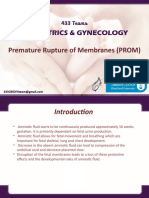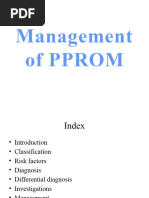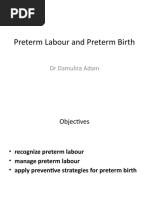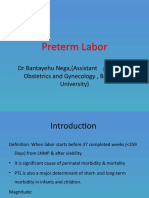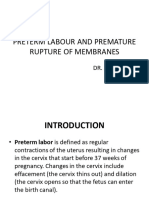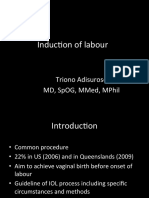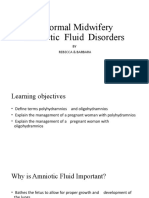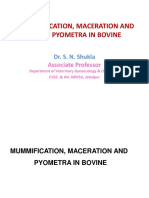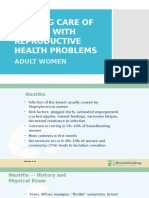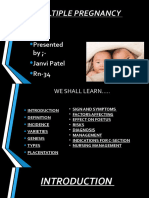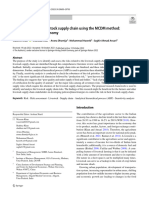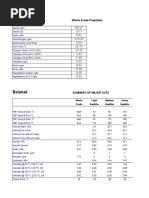Prematurely Ruptured of Membranes - PROM
Prematurely Ruptured of Membranes - PROM
Uploaded by
William JensenCopyright:
Available Formats
Prematurely Ruptured of Membranes - PROM
Prematurely Ruptured of Membranes - PROM
Uploaded by
William JensenOriginal Description:
Original Title
Copyright
Available Formats
Share this document
Did you find this document useful?
Is this content inappropriate?
Copyright:
Available Formats
Prematurely Ruptured of Membranes - PROM
Prematurely Ruptured of Membranes - PROM
Uploaded by
William JensenCopyright:
Available Formats
Premature Ruptured of
Membranes (PROM)
R. Afrilianti
Definition
PROM is defined as spontaneous rupture of
the membranes (amniorrhexis) before labor at
any stage of gestation
If the rupture happened prior to 37 weeks, it
called preterm prematurely rupture of the
membranes (PPROM)
Epidemiology
In normal condition, 8 10 % of term
pregnancy woman happened PROM
PPROM occurs in about 1 % of all pregnancy
Etiology
The cause of
PROM is a wide
array of
pathological
mechanisms.
PROM PPROM
Weakness power of
membranes in term
pregnancy, cause of:
-Enlarge uterus
-Uterus contraction
-Movement of fetal
External factors included:
-Vaginal infection
-Trauma
-Increased of intra-uterine
pressure (such as multiple
pregnancy and hydraminios)
-Solutio placenta
-Cervix incompetent
Change biochemistry process
of membranes
Low socioeconomic status
Low body mass indexless than
19.8
Nutritional deficiencies
Cigarette smoking
Physiology
Amniotic sac
Inner layer (amnion)is
formed by embryo-
blasts.
Outer layer (chorion)is
formed by tropho-blasts
As a metabolic organ, it is part of the production and
Resorption of the amniotic fluid
The fetal kidney and the fetal lung produce
the amniotic fluid. Resorption occurs via the
amniotic sac and the gastrointestinal system
when the fetus drinks the amniotic fluid.
Function
Shelter from dehydration, compression of the
umbilical cord, traumatic external influences
and gives room for the child to move and grow
and necessary for the development of the
lungs
Patophysiology
PROM is correlated with change of
biochemistry process of component the
membranes including collagen matrix
extracellular amnion, chorionic, and apoptosis
of fetal membranes
In normal condition, rupture of membranes in
delivery commonly happened by uterus
contraction and stretching repeated of
membranes
Synthesis and degradation matrix extracellular
must be in balance condition.
Collagen degradation is mediated by
metaloproteinase matrix (MMP).
Its inhibited by specific tissue inhibitor and
protease inhibitor
While delivery approached, degradation
activity is increased. In infection condition
occurs increase of MMP stimulating matrix
degrading enzyme PROM
Manifestation
Fluid passing through the vagina suddenly,
and then small amounts of fluid flow through
the vagina intermitently, particularly when the
increased of abdominal pressure (cough,
sneeze, et al)
Intermittent urinary leakage is common
during pregnancy, especially near term
Increased vaginal secretions in pregnancy
Perineal moisture
Increased cervical discharge
Urinary incontinence
Speculum examination appears loss of
amniotic fluid from the endocervical canal
Nitrazin paper changed from red to blue
Lanugo and vernix casseosa by microscope
Evaluation
1. History
The time of rupture and consistency of the
fluid leakage is important.
An accurate gestational age to
appropriately manage the patient
2. Examination
- Vital sign
- Sterile speculum examination (SSE)
When visualizing the cervix, the dilation and
effacement should be noted
Nitrazin and fern tests are used to confirm
rupture. Nitrazin should show a pH between
7,1 7,3. False positive test can be observed
with blood, semen, trichomonas, cervical
mucus, and urine
Ferning can be falsely negative in the
presence of blood.
Cervical culture for chlamydia and
gonorrhea, and anovaginal culture for group
B streptococcus should be obtained
- Fundal tenderness
Evaluation for possible chorioamnionitis or
placenta abruption
- Laboratory assessment
Complete blood count and urinalysis
- Ultrasound (USG)
Amnion fluid index, fetal presentation,
estimated fetal weight, and gestaional age
- Fetal heart rate and contraction monitoring
Maternal and fetal risks
Maternal risk Fetal risk
Amniotic infection syndrome (AIS)
Sepsis
Placental abruption
Postpartal atonia
Fever and endomyometritis in
peurperium
Increase CS insidency
Preterm brith
Neontal sepsis
Pulmonary hypoplasia
RDS
Contractures and deformities
Treatment guidelines in preterm
rupture of membranes
Conservative management
Antibiotic
- ampicillin 4x500mg/erytromicin 4x500mg
- metronidazole 2x500 mg to 7 days
GA32-34 weeks hospitalize until amniotic
fluid stop to loss
GA 32-37 weeks no in labour and infection,
administer dexamethasone observation
termination at 37th week
GA 32-37 weeks in labour and non infection
tocolytic agent (salbutamol), dexamethasone do
induction after 24 hours
GA 32-37 weeks infection administer
antibiotic and induction
GA 32-37 weeks administer steroid
(Betametasone 12 mg/day single dose for 2
days), Dexametasone IM 5 mg/6hours 4X.
Active management
GA >37 weeks do induction with oxitocin if
failed CS
Misoprostol 25g - 50g intravagina/6 hours
4X. If any infection give high dose of antibiotic
and termination pregnancy
If pelvic score <5, favorable cervix then
induction. If failed SC
If pelvic score >5 induction
References
Mohr T. Premature Rupture of Membrane.
Gynakol Geburtsmed Gynakol Endokrinol
2009; 5(1):2836.
Prawirohardjo S. Ilmu Kebidanan. Ed 4th.
Jakarta: PT. Bina Pustaka Sarwono
Prawirohardjo, 2009.
Mercer BM. Premature Rupture of The
membrane in Maternal fetal Medicine:
Elsevier 2010
You might also like
- Www. Bobcat-: Service Manual T190 Compact Track LoaderDocument888 pagesWww. Bobcat-: Service Manual T190 Compact Track LoaderRene CuencaNo ratings yet
- ENG TECH 4MA3 Assignment 2020 FallDocument6 pagesENG TECH 4MA3 Assignment 2020 FallRyan TorresNo ratings yet
- Fireground HydraulicsDocument114 pagesFireground HydraulicsNaeem IqbalNo ratings yet
- 2022 Mathematics Atp Grade 7Document7 pages2022 Mathematics Atp Grade 7Themba NyoniNo ratings yet
- Induction and Augmentation of LaborDocument22 pagesInduction and Augmentation of LaborDagnachew kasaye100% (2)
- Supreme Magus Volume 3Document5 pagesSupreme Magus Volume 3eliasNo ratings yet
- Prematurely Ruptured of Membranes (PROM)Document23 pagesPrematurely Ruptured of Membranes (PROM)NiNie Sie MbakayuNeNo ratings yet
- Premature Rupture of MembranesDocument29 pagesPremature Rupture of MembranesIda YosopaNo ratings yet
- Premature Rupture of Membranes (PROM)Document22 pagesPremature Rupture of Membranes (PROM)vishnu mugilNo ratings yet
- PromDocument28 pagesPromSemon YohannesNo ratings yet
- Premature Rupture of MembranesDocument33 pagesPremature Rupture of MembranesSarang Lee100% (1)
- Prom 1Document48 pagesProm 1Tesfahun TekleNo ratings yet
- 24 Intrauterine Fetal Growth Restriction and Amniotic Fluid DisordersDocument23 pages24 Intrauterine Fetal Growth Restriction and Amniotic Fluid DisordersÕbsëqúiœus Menam MikreNo ratings yet
- Induction and AugmentationDocument50 pagesInduction and AugmentationchabsidarbiNo ratings yet
- Premature Rupture of The MembranesDocument6 pagesPremature Rupture of The MembranesMaria Donabella OngueNo ratings yet
- 18 PromDocument8 pages18 PromRyubusa HayabusaNo ratings yet
- Management of PPROM Edit 1Document45 pagesManagement of PPROM Edit 1lohujiherNo ratings yet
- Premature Rupture of MembranesDocument38 pagesPremature Rupture of MembranesArwa QishtaNo ratings yet
- Obgy-Wln Late Pregnancy Complications: Kabwe Central HospitalDocument15 pagesObgy-Wln Late Pregnancy Complications: Kabwe Central HospitalEmmanuel MukukaNo ratings yet
- Preterm Labour: Introduction and Causes by Humna AnisDocument19 pagesPreterm Labour: Introduction and Causes by Humna AnisManjunath VankadariNo ratings yet
- KPSW Dan Sepsis Kemayoran 160719Document54 pagesKPSW Dan Sepsis Kemayoran 160719budiNo ratings yet
- Preterm LaborDocument29 pagesPreterm LaborBer AnneNo ratings yet
- Preterm Pre-Labour Rupture of MembranesDocument48 pagesPreterm Pre-Labour Rupture of Membranesnyiramahirwe theodetteNo ratings yet
- Premature Rupture of MembranesDocument39 pagesPremature Rupture of MembranesROLEX JUMANo ratings yet
- PROM (Prelabor Rupture of Membranes)Document20 pagesPROM (Prelabor Rupture of Membranes)lohujiherNo ratings yet
- Complications of 3rd TrimesterDocument49 pagesComplications of 3rd TrimesterMA. JYRELL BONITONo ratings yet
- Pprom 1 1Document20 pagesPprom 1 1Tehreem Azhar100% (1)
- Management of Abortion,Unsafe Abortion, Post Abortal CareDocument33 pagesManagement of Abortion,Unsafe Abortion, Post Abortal Carebentley.wes78No ratings yet
- Premature RuptureDocument30 pagesPremature RuptureSanthosh.S.U100% (1)
- Preterm Labour and PROMDocument25 pagesPreterm Labour and PROMNinaNo ratings yet
- Ob EmergenciesDocument58 pagesOb Emergenciessanthiyasandy100% (2)
- Gyno... PTL & PRODocument30 pagesGyno... PTL & PROhailemichael chekolNo ratings yet
- Preterm Labour: Pembimbing: Dr. Andriana Kumala Dewi, SP - OGDocument33 pagesPreterm Labour: Pembimbing: Dr. Andriana Kumala Dewi, SP - OGJovian LutfiNo ratings yet
- Premature Rupture of The MembranesDocument21 pagesPremature Rupture of The MembranesMeta SariNo ratings yet
- Preterm Labor-1Document28 pagesPreterm Labor-1tajfaiz779No ratings yet
- Induction Obstructed PrecipitateDocument38 pagesInduction Obstructed PrecipitateRose NyamburaNo ratings yet
- Preterm LaborDocument62 pagesPreterm LaborAstri Sri Widiastuty100% (1)
- Induction of LabourDocument59 pagesInduction of LabourFadiaislamiNo ratings yet
- PRETERM DELIVERY With NARRATIONDocument23 pagesPRETERM DELIVERY With NARRATIONamanda deonananNo ratings yet
- Fetal Dev, AbortionDocument128 pagesFetal Dev, AbortionAr JayNo ratings yet
- Premature Rapture of Membrane.Document13 pagesPremature Rapture of Membrane.Sadia SiddikiNo ratings yet
- Amniotic Fluid DisordersDocument22 pagesAmniotic Fluid Disordersvictor onapaNo ratings yet
- PROM SANJIDA FInal 2Document32 pagesPROM SANJIDA FInal 2Saiful islam RonyNo ratings yet
- Abortion, Ectopic PregnancyDocument139 pagesAbortion, Ectopic PregnancyINFORMASI MENARIK100% (1)
- Premature Rupture of MembraneDocument17 pagesPremature Rupture of MembraneShimaa Abdel hameedNo ratings yet
- Mummification Maceration PyometraDocument16 pagesMummification Maceration PyometrafeyisaNo ratings yet
- Prelabor Rupture of Membranes (Prom) : By-Aditi Grover Roll No. - 3Document12 pagesPrelabor Rupture of Membranes (Prom) : By-Aditi Grover Roll No. - 3San SiddzNo ratings yet
- Maternal HealthDocument90 pagesMaternal HealthShaafieNo ratings yet
- PhimosisDocument36 pagesPhimosisNamrata Karki100% (2)
- Management of Pregnancy With Premature Rupture of Membranes (Prom)Document6 pagesManagement of Pregnancy With Premature Rupture of Membranes (Prom)Ryzka Izza MayFanyNo ratings yet
- PromDocument45 pagesPromgaredewasnakeayeleNo ratings yet
- Recurrent Miscarriage - Pregnancy LossDocument34 pagesRecurrent Miscarriage - Pregnancy Losszianab aliNo ratings yet
- PPROMDocument12 pagesPPROMBright KumwendaNo ratings yet
- Nursing Care of Clients With Reproductive Health ProblemsDocument100 pagesNursing Care of Clients With Reproductive Health ProblemsHassen ZabalaNo ratings yet
- 14 Postterm Pregnancy and Intrauterine Fetal DeathDocument25 pages14 Postterm Pregnancy and Intrauterine Fetal DeathÕbsëqúiœus Menam MikreNo ratings yet
- MultigravidaDocument25 pagesMultigravidaMukund ChauhanNo ratings yet
- Female Sub FertilityDocument75 pagesFemale Sub FertilityIshaThapa100% (1)
- 05b KPSW Dan SepsisDocument34 pages05b KPSW Dan SepsisIsmi RatnasariNo ratings yet
- Multiple Pregnancy: Nirav Hitesh Kumar ValandDocument28 pagesMultiple Pregnancy: Nirav Hitesh Kumar ValandNirav SharmaNo ratings yet
- University of Saint Louis Tuguegarao City, Philippines: Maternal and Child Health NursingDocument94 pagesUniversity of Saint Louis Tuguegarao City, Philippines: Maternal and Child Health NursingErica Veluz LuyunNo ratings yet
- Google 4Document5 pagesGoogle 4sintaraNo ratings yet
- Bleeding in Early PregnancyDocument34 pagesBleeding in Early PregnancyAdenike OLAOGUNNo ratings yet
- Preterm Labour - PgDocument43 pagesPreterm Labour - PglakshyaavuppalaNo ratings yet
- Lecture 11 Bovine and Bubaline Infertility-Non-specific Genital AffectionsDocument54 pagesLecture 11 Bovine and Bubaline Infertility-Non-specific Genital AffectionsgnpobsNo ratings yet
- List of MaterialDocument3 pagesList of MaterialAchmed Farrin OthmanNo ratings yet
- Module Lesson 3 Equipments in BadmintonDocument8 pagesModule Lesson 3 Equipments in BadmintonJerald CañeteNo ratings yet
- SondagaandeDocument5 pagesSondagaandedh8phkyjdtNo ratings yet
- DGS 700 ManualDocument28 pagesDGS 700 Manualcarla monic dialinoNo ratings yet
- Beige Brown Playful Cute Illustration October Monthly Planner Journal Agenda PresentationDocument20 pagesBeige Brown Playful Cute Illustration October Monthly Planner Journal Agenda Presentation2w2tkd2ptbNo ratings yet
- Packaging Present. FinalDocument34 pagesPackaging Present. FinalJitendra Yadav0% (1)
- Food Waste in Rst. Pakistan PDFDocument21 pagesFood Waste in Rst. Pakistan PDFKaruna DhuttiNo ratings yet
- Unit Test 4BDocument6 pagesUnit Test 4BTania CorreiaNo ratings yet
- Care of Spinal Injury Patient With Paraplegia and QuadriplegiaDocument54 pagesCare of Spinal Injury Patient With Paraplegia and Quadriplegia21.FARHANI100% (1)
- Risk Assessment in Livestock Supply Chain Using The MCDM Method: A Case of Emerging EconomyDocument16 pagesRisk Assessment in Livestock Supply Chain Using The MCDM Method: A Case of Emerging EconomyAsrullah AsNo ratings yet
- IO Manual E4Document48 pagesIO Manual E4V.A. Elvien Kristian PrasetyoNo ratings yet
- Animals Everywhere Grammar Drills Picture Description Exercises Readi 98317Document2 pagesAnimals Everywhere Grammar Drills Picture Description Exercises Readi 98317anagalac2344No ratings yet
- TRL2604 Study NotesDocument46 pagesTRL2604 Study Notesabdessamadlotfi02No ratings yet
- Zxtec Tension ControllerDocument16 pagesZxtec Tension ControllerNisar AhmedNo ratings yet
- NCS001 (E) SugarDocument38 pagesNCS001 (E) Sugarrudy_423522658No ratings yet
- Civil Enforcement Handbook V 2Document56 pagesCivil Enforcement Handbook V 2Olaf RazzoliNo ratings yet
- Belanak: Whole Crude PropertiesDocument6 pagesBelanak: Whole Crude PropertiesHeron SurbaktiNo ratings yet
- The ColorDisk 1.5Document1 pageThe ColorDisk 1.5ad cruzNo ratings yet
- The Quality of Life in Post - Mucormycosis PatientDocument4 pagesThe Quality of Life in Post - Mucormycosis PatientInternational Journal of Innovative Science and Research Technology100% (1)
- Amp & Cab Model List - Help CenterDocument1 pageAmp & Cab Model List - Help CenterGAMES TORRENTNo ratings yet
- NavEdit ManualDocument52 pagesNavEdit ManualDaeng KulleNo ratings yet
- Corrosion Science: L.Y. Xu, Y.F. ChengDocument7 pagesCorrosion Science: L.Y. Xu, Y.F. ChengHaniel FcNo ratings yet
- Procter & Gamble: Using Agent Based Modeling and RFID: Supply Chain ManagementDocument18 pagesProcter & Gamble: Using Agent Based Modeling and RFID: Supply Chain ManagementJames KudrowNo ratings yet
- Mechanics of Materials Lab Fall 2018Document52 pagesMechanics of Materials Lab Fall 2018Hammad RazaNo ratings yet
- How To Save Power by Induction MotorDocument3 pagesHow To Save Power by Induction Motorshamim islamNo ratings yet








